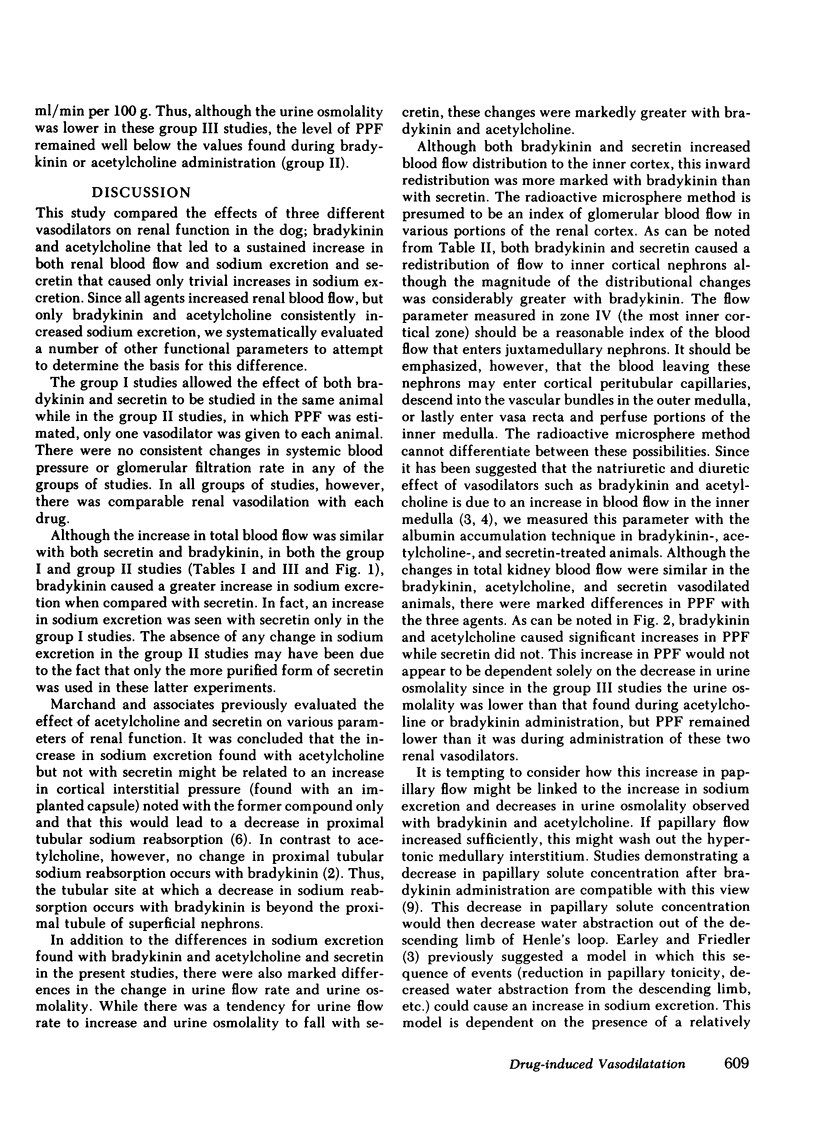Abstract
The administration of vasodilating agents such as bradykinin and acetylcholine cause an increase in urinary sodium excretion. Yet the mechanisms involved in this natriuretic effect are not clear. Recent studies with another renal vasodilator, secretin have shown this drug also causes a profound increase in renal blood flow but without major changes in sodium excretion. To attempt to delineate the basis of this difference in sodium excretion with these drugs, the renal functional effects of secretin and bradykinin were compared at an equivalent vasodilating dose. Bradykinin increased renal blood flow from 222 to 342 ml/min, urine volume from 0.2 to 1.2 ml/min, and urine sodium excretion from 28 to 115 μeq/min. Urine osmolality fell from 1,230 to 401 mosmol/kg. Secretin caused a comparable increase in renal blood flow (216 to 325 ml/min) while changes in urine flow, sodium excretion, and urine osmolality were significantly less.
In further studies papillary plasma flow was estimated using the albumin accumulation technique. Control papillary plasma flow was 29 ml/min per 100 g. Bradykinin increased urinary sodium excretion 108 μeq/min and decreased urinary osmolality from 1,254 to 516 mosmol/kg in association with a rise in papillary plasma flow to 62 ml/min per 100 g. Urine sodium excretion, urinary osmolality, and urine flow rate, as well as papillary plasma flow rate (32 ml/min per 100 g) were unchanged from control when secretin was administered. Studies with acetylcholine were qualitatively similar to those of bradykinin. Renal blood flow increased from 150 to 248 ml/min, urinary sodium excretion increased from 20 to 243 μeq/min, urinary osmolality decreased from 1,237 to 411 mosmol/kg and papillary plasma flow increased from 39 to 52 ml/min per 100 g. It is suggested that the natriuretic effect of some vasodilators is due, at least in part, to alterations in medullary hemodynamics, as evidenced by the increase in papillary plasma flow seen with bradykinin and acetylcholine, but not secretin.
Full text
PDF






Selected References
These references are in PubMed. This may not be the complete list of references from this article.
- Chuang E. L., Reineck H. J., Osgood R. W., Kunau R. T., Jr, Stein J. H. Studies on the mechanism of reduced urinary osmolality after exposure of renal papilla. J Clin Invest. 1978 Mar;61(3):633–639. doi: 10.1172/JCI108974. [DOI] [PMC free article] [PubMed] [Google Scholar]
- EARLEY L. E., FRIEDLER R. M. CHANGES IN RENAL BLOOD FLOW AND POSSIBLY THE INTRARENAL DISTRIBUTION OF BLOOD DURING THE NATRIURESIS ACCOMPANYING SALINE LOADING IN THE DOG. J Clin Invest. 1965 Jun;44:929–941. doi: 10.1172/JCI105210. [DOI] [PMC free article] [PubMed] [Google Scholar]
- LILIENFIELD L. S., MAGANZINI H. C., BAUER M. H. Blood flow in the renal medulla. Circ Res. 1961 May;9:614–617. doi: 10.1161/01.res.9.3.614. [DOI] [PubMed] [Google Scholar]
- Lewy J. E., Windhager E. E. Peritubular control of proximal tubular fluid reabsorption in the rat kidney. Am J Physiol. 1968 May;214(5):943–954. doi: 10.1152/ajplegacy.1968.214.5.943. [DOI] [PubMed] [Google Scholar]
- Marchand G. R., Hubel K. A., Williamson H. E. Effects of secretin on renal hemodynamics and excretion. Proc Soc Exp Biol Med. 1972 Apr;139(4):1356–1358. doi: 10.3181/00379727-139-36362. [DOI] [PubMed] [Google Scholar]
- Marchand G. R., Ott C. E., Lang F. C., Greger R. F., Knox F. G. Effect of secretin on renal blood flow, interstitial pressure, and sodium excretion. Am J Physiol. 1977 Feb;232(2):F147–F151. doi: 10.1152/ajprenal.1977.232.2.F147. [DOI] [PubMed] [Google Scholar]
- Martinez-Maldonado M., Tsaparas N., Eknoyan G., Suki W. N. Renal actions of prostaglandins: comparison with acetylcholine and volume expansion. Am J Physiol. 1972 May;222(5):1147–1152. doi: 10.1152/ajplegacy.1972.222.5.1147. [DOI] [PubMed] [Google Scholar]
- McGiff J. C., Itskovitz H. D. Prostaglandins and the kidney. Circ Res. 1973 Nov;33(5):479–488. doi: 10.1161/01.res.33.5.479. [DOI] [PubMed] [Google Scholar]
- Osgood R. W., Reineck H. J., Stein J. H. Further studies on segmental sodium transport in the rat kidney during expansion of the extracellular fluid volume. J Clin Invest. 1978 Aug;62(2):311–320. doi: 10.1172/JCI109131. [DOI] [PMC free article] [PubMed] [Google Scholar]
- Stein J. H., Congbalay R. C., Karsh D. L., Osgood R. W., Ferris T. F. The effect of bradykinin on proximal tubular sodium reabsorption in the dog: evidence for functional nephron heterogeneity. J Clin Invest. 1972 Jul;51(7):1709–1721. doi: 10.1172/JCI106972. [DOI] [PMC free article] [PubMed] [Google Scholar]
- Willis L. R. Effect of bradykinin on the renal medullary osmotic gradient in water diuresis. Eur J Pharmacol. 1977 Sep 15;45(2):173–183. doi: 10.1016/0014-2999(77)90087-5. [DOI] [PubMed] [Google Scholar]


